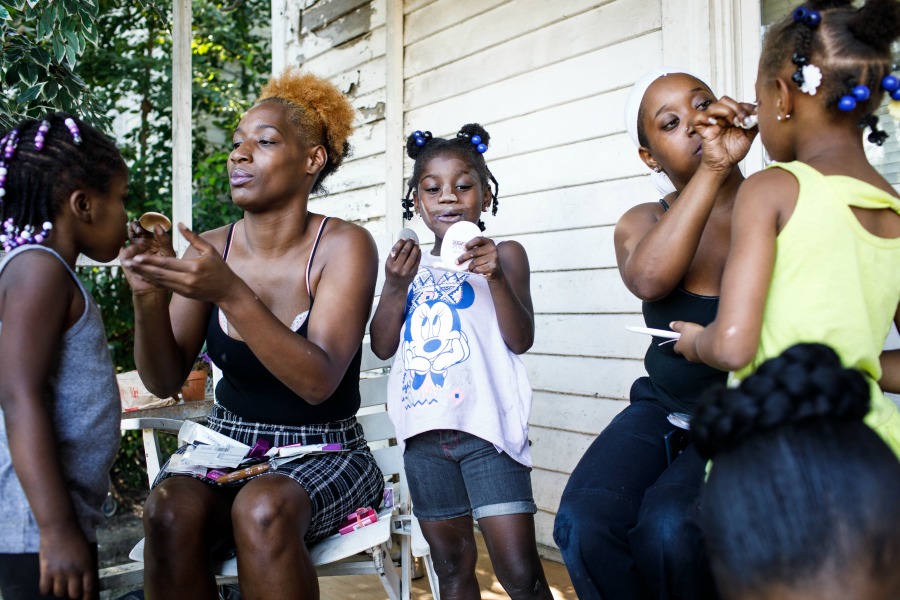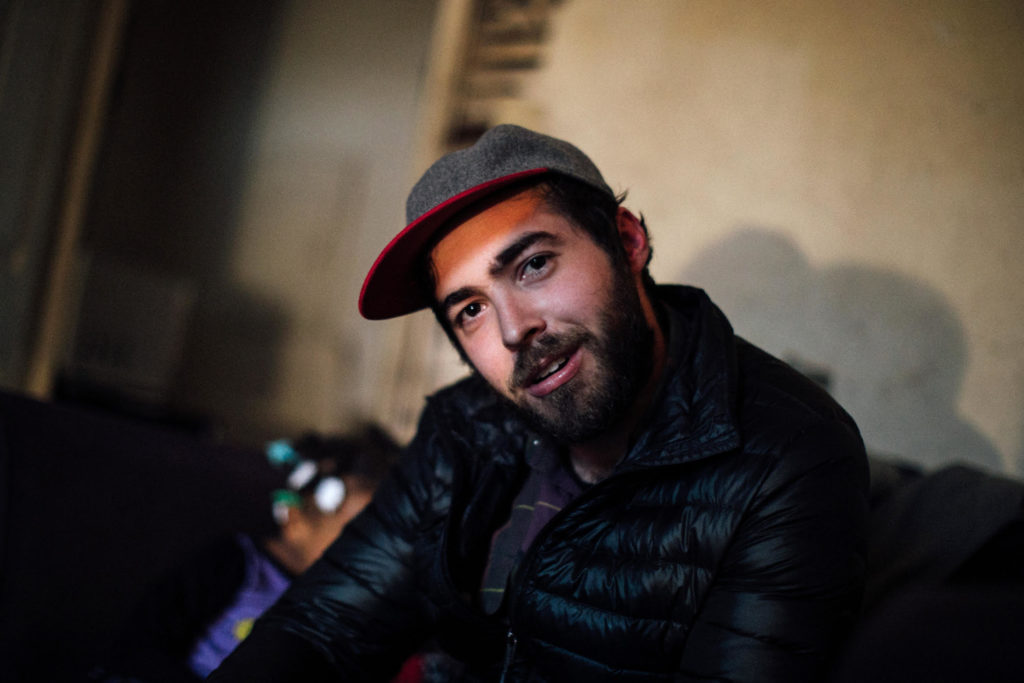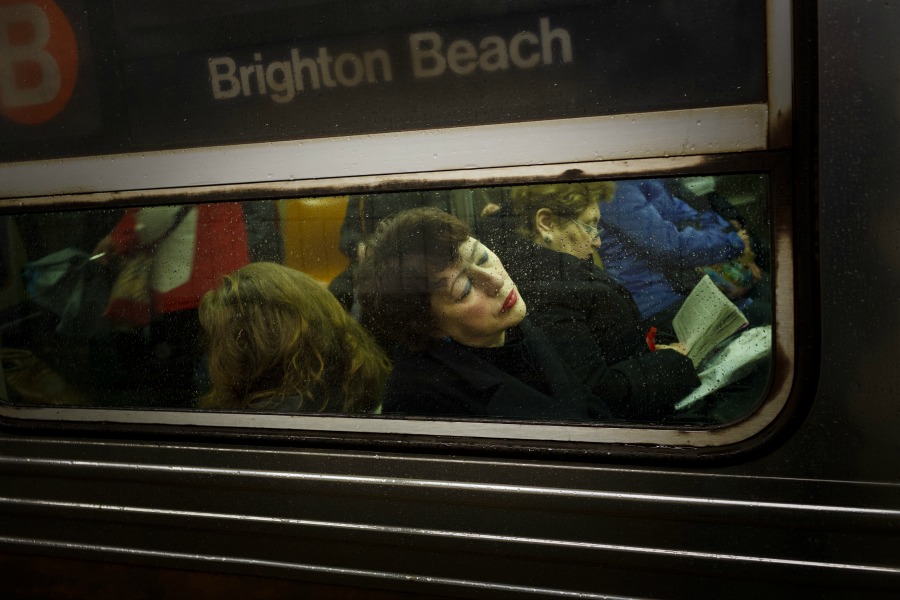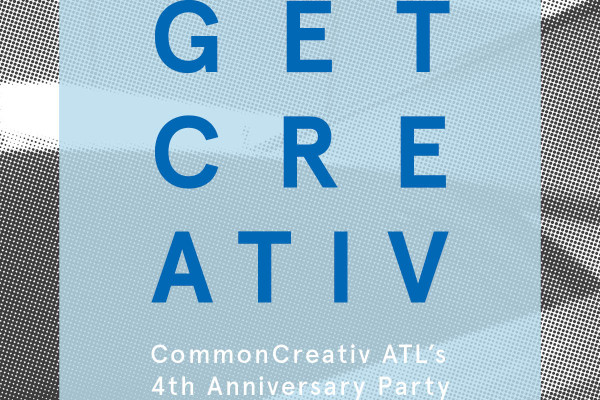Dustin Chambers doesn’t chase light — he prefers to observe it.
Before drawing a camera to his eye, the professional photographer likes to take time to talk and establish trust with people. Like a cinema, he watches as stories unfold before him, seeing that the stories to be told are not always in center and focus, but in the periphery — the edges, the fringes, what lies beneath and beyond. Chambers notices the lady on the subway, the forgotten families that face the burdens of urban development, and tries to see the light in each situation. “I’m interested in cultivating a deep sensitivity to light in every situation,” he says. “I know that if I can represent the light as it falls upon a scene as truthfully as possible, the image gets closer to something you can touch and feel.“
Chambers is almost like a photographic lens himself, focusing and refocusing in life and work. His photojournalism and work have appeared in an array of publications like VICE and The New York Times, and he’s shot videos for everyone from rappers to acclaimed chefs.
Here, Chambers talks with CommonCreativ about his “Beyond the Dome” project, photographing Jon Ossoff’s campaign, and loving Atlanta for the art punks that disrupt the city.
CommonCreativ: What got you into photography and photojournalism?
Dustin Chambers: I was always an observer and a tinkerer. I liked to watch people and figure out how mechanical things worked. When I first got my hands on a camera, my first fascination was with the mechanics. In the ‘90s, my mom taught photography and design at the Portfolio Center and my dad was a freelance advertising photographer. A camera was never really shoved into my hands, but I was absorbing the images around me whether at the studio, at my mom’s work, or home, places I was equally likely to end up after the school day. I’d study my dad’s test Polaroids, my mother’s students’ work hanging in the halls of the school, and the photo books that [were] around our house.
I started making my first pictures in early high school, taking black and white film classes at my school from a teacher named George Mitchell. This was the first time I recognized a focused interest in reality, pushing against the fabricated realities that my dad was charged with creating in his studio. After junior year of college (I was an English major at Appalachian State), I did a summer internship at Creative Loafing. Once I graduated I was able to freelance for them and eventually become a part-time staff member as the assistant photo editor. I worked under Joeff Davis, a seasoned photojournalist who I continue to collaborate with. From there, it was saying yes to almost everything and working really really hard.
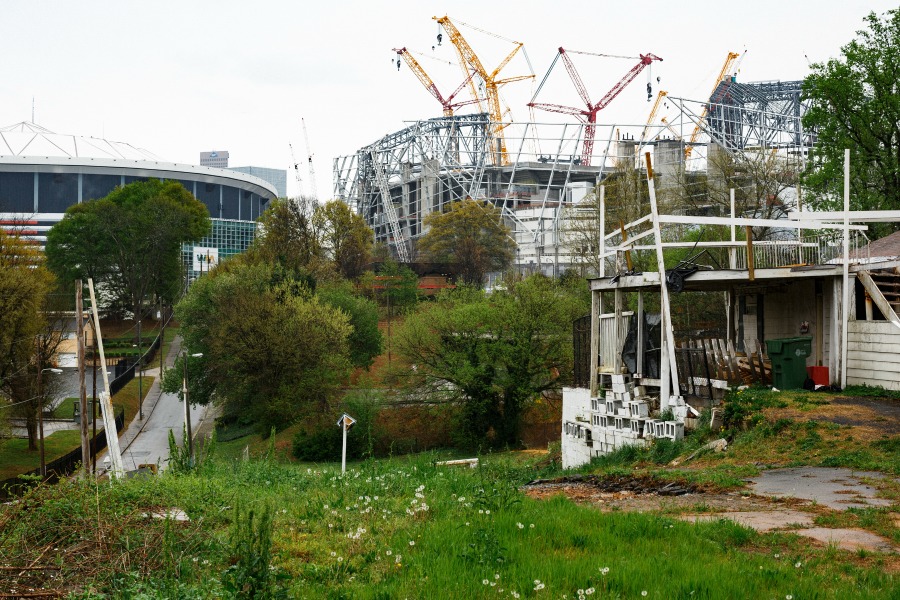
Photo by Dustin Chambers // March 23, 2016 – The construction of the new $1.2 billion Falcons Stadium next to Atlanta’s current football stadium, The Georgia Dome, as seen from the yard of an unoccupied English Avenue home.
I’d go from photographing some award-winning hot dog for Creative Loafing to shooting and editing music videos for local rappers, to working as a production assistant on Good Eats with Alton Brown. It was knocking on the doors I wanted to have my foot in, like The New York Times, and going to photojournalism workshops, making sure I got a proper education in the ethics and workflow of photojournalists.
CC: You mentioned a season of saying “yes” to almost everything. How do you decide what to pursue and get involved with now?
DC: It’s always the triad of money, time, and experience/product. I’ve done projects that are rich in experience, that took a long time, and paid nothin’, as well as really super boring not exciting jobs that paid a bunch. It’s always a balance as a freelance creative. In the beginning, you want to learn and you want people to know your name, so you say “yes, yes, yes.” There’s an exciting perseverance that kicks in when you’re overcommitted juggling 10 different projects in your head, but I’ve found that I’m a good deal happier when I can put in a more concerted effort.
CC: Where do you find inspiration?
DC: Photojournalism is the best because it’s a tool that can be applied to anything visual. So I let my interest in the world drive my photographic inspiration and pursue things I want to know about or understand deeper. The best is being called for an assignment and knowing you’re in for a unique experience. Last week I shot an assignment for The New York Times about dogs getting MRIs at Emory – for science! It’s like, I didn’t know that was even a thing to know about but now I’m fascinated.
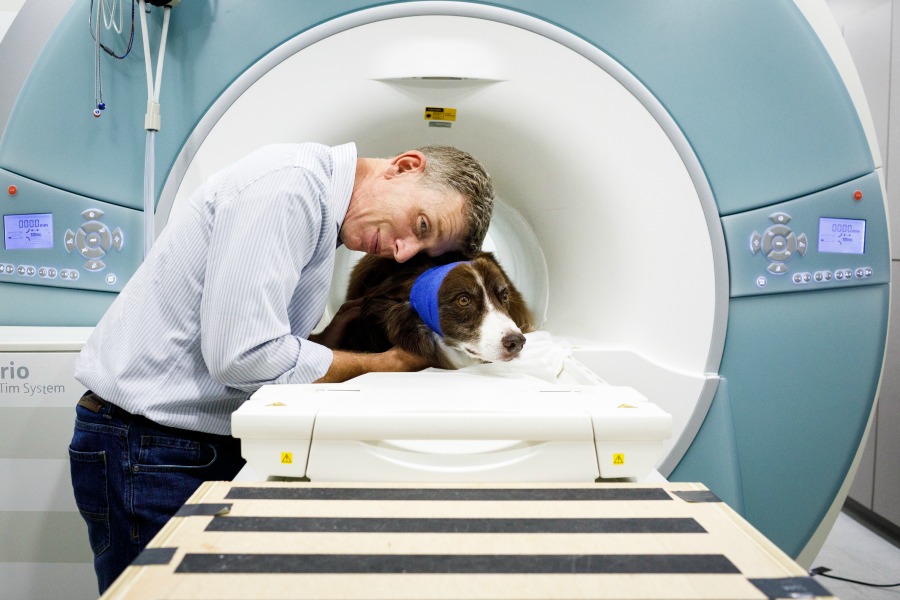
Photo by Dustin Chambers // July 13, 2017 – Wil, an australian shepherd, is photographed on the MRI machine at Emory University. His head is wrapped with medical gause to hold in his ear-plugs to protect from the MRI’s very loud sounds.
CC: Do you have any favorite tools or processes?
DC: In terms of process, the most important thing is listening to subjects. There is no tool that will yield a better photo than putting the camera away and simply spending time with someone to gain their genuine trust.
CC: Tell us more about “Beyond the Dome.”
DC: “Beyond The Dome” is a project I’ve been working on since 2015 after the new Mercedes-Benz stadium was announced. Since the announcement of the stadium, homes in the two communities [surrounding it] have been torn down by the National Guard, streets have been repaved, parks have been improved, apartment buildings painted. Large-scale drug busts have been carried out. While necessary, these are superficial improvements for those who have lived in these communities through decades of tumult, and to some ominously impending change. Right now, the area is relatively quiet, according to folks who grew up there. With over half of the buildings in the area empty, held by realtors who plan to flip the homes when property values rise, and only 15 percent of the residents owning their homes, the fragility of the community is clear.
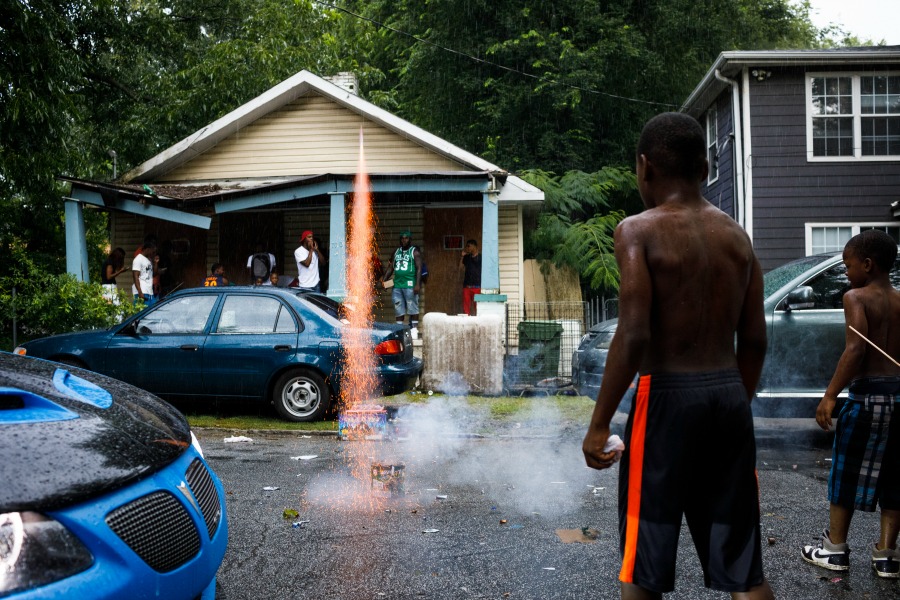
Photo by Dustin Chambers // July 4, 2017 – Fourth of July fireworks at a block party on English Avenue.
I’ve photographed the people who have become pronouns, lost in the development, the non-profits, the promises and programs. A matriarch of four generations under one roof named Chiquilia Ogletree; a man named Kurt that sells drugs three houses down; Heaven, Quita, and Bubba who just graduated kindergarten; a twentysomething named Brandon from an Atlanta suburb who came to buy heroin and stayed to keep using it; a man named Dexter who got out of jail two years ago after 13 years and lives with his parents — his mother runs a salon out of the back of the house.
The Mercedes-Benz stadium is scheduled to open on Aug. 26, 2017, with a Falcons preseason game against the Arizona Cardinals, and is scheduled to host Super Bowl LIII in 2019. I’m sure that the building of the stadium and the $250 million neighborhood improvement projects it’s spurred will cosmetically improve the neighborhoods, but will the original residents’ lives be improved? Will they have better access to healthcare, healthy food, and economic opportunity? Or will they be dashed from the history of their own space?
CC: Your passion for “Beyond The Dome” comes through in the images. What inspired you to start it?
DC: After the new stadium announcement, I talked about an interest in the possibility of a project to a friend who was doing healthcare surveys of heroin users. She had actually met a couple of users on English Avenue and, out of her own curiosity, had spent more time with them than was necessary. One day she called and asked me if I wanted to meet them. So we spent time with them in their squat where they shot up and they let me photograph. I was stunned with their trust and understanding of the kind of story I wanted to tell. I walked around the neighborhood with them a few times and it was the first time folks saw me vouched for by others in the community. Once I had that access, I knew I should pursue the broader aspects of the neighborhood.
CC: You also spent time on the campaign trail with Jon Ossoff — what was that like?
DC: I grew up with Jon, we’ve been in a very tight group of friends since ninth grade, so it was surreal and heartening to see him out there. It is one of the greatest honors of my life, to work for someone you love as they courageously put themselves into such a challenging situation. It was painful to see his stress and exhaustion but deeply inspiring to see him persevere. June 20th was difficult, but the loss wasn’t something I really let myself feel until the weeks after.
CC: Thinking back to all of your work, what’s your favorite photo that you’ve made?
DC: It’s still hard for me to look back at some work, but I will always love the subway lady. I find peace in the photo, I’m just comforted by the way it feels. It was also such a fleeting image – I was getting off a subway car, turned around, saw this woman, and made a single frame. Then, she was gone. I still think about what she was feeling then and what she feels now, I wish I knew. My own personal mystery.
CC: What’s your philosophy when it comes to how you approach social media?
DC: I like Instagram — it’s much less angry and sad than Facebook, but I don’t have any sort of schema or schedule in terms of posting. I post photos I like and that I’m proud of. The validation is helpful for sure, but I decided that I wasn’t going to build my career around social media a while ago. It’s superficial and really stress-inducing when I let myself care about it too much.
CC: What is it about Atlanta and the local arts scene that you love?
DC: Atlanta’s been known as having a dynamic and flexible arts scene. I think that stands true. You can break into any project or program if you ask or apply yourself. In other cities there are more structured ladders to artistic success, Atlanta seems to be more inclusive. I’m excited to see the art punks disrupt the development taking place on every block of our city. I love that the Downtown Players Club exists. These organizations are holding and activating vital space in an unused core of our city, Downtown, that’s about to explode with development.
CC: Got any last words of advice for budding artists?
DC: Know that you are not the best. Ask to spend time with people who do it better and soak it up. Observe more than you speak. Be kind and work hard.
You can see more of Dustin Chambers’ photography on his site and on Instagram.

